Notes: Plants | EVS & Pedagogy Paper 1 for CTET & TET Exams - CTET & State TET PDF Download
Plants are living things that grow in the ground. They need sunlight, water, air, and soil to grow. Plants have different parts like roots, stems, leaves, flowers, and fruits. Roots help plants stay in the soil and absorb water and nutrients. Leaves make food for the plant through a process called photosynthesis. Flowers can turn into fruits, which contain seeds to grow new plants. Plants are important because they give us oxygen to breathe and food to eat. 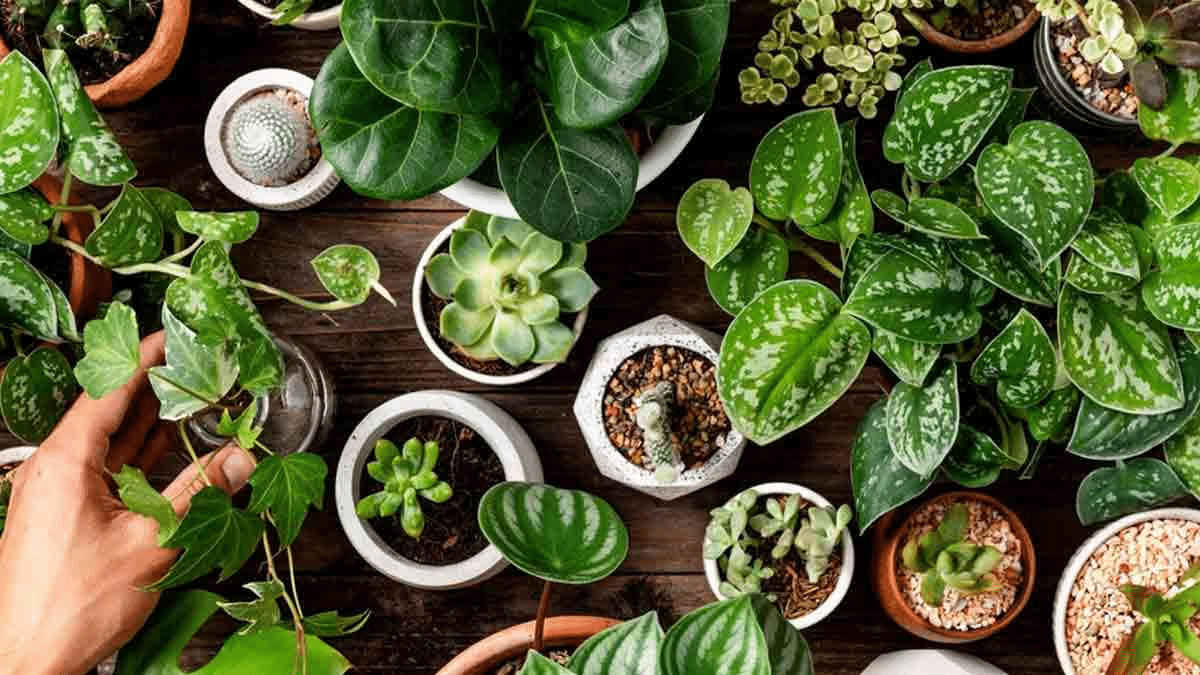
- Plant is very broad and it includes single celled algae to flower and fruit bearing trees.
- Plants may be terrestrial or aquatic, plants which are present on the land surface is called terrestrial plant.
- Plant which floats, submerged or remain suspended in water is called aquatic plants.
Different Parts of Plants
The entire structure of a plant is divided into different parts, each performing distinct functions. The different parts of plants are as follows:
I. Root System
The root system helps in the absorption of water and nutrients from the soil, which are essential for the growth of the plant.
- Radicle: The first root that emerges from a plant is called the radicle.
- Root Hairs: Tiny hair-like structures on the roots that increase the surface area for absorption.
The root system consists of roots, root hairs, and all their parts.
There are two main types of root systems:
1. Tap Root System
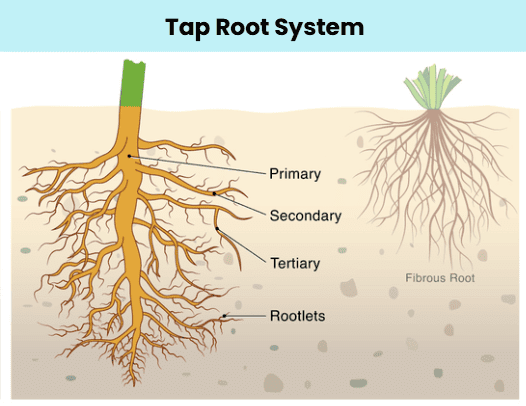
- Characteristics: A large, central, and dominant root from which other roots sprout laterally.
- Development: Tap roots develop from the radicle of a seed, forming the primary root. This primary root branches into secondary roots and further into tertiary rootlets.
Modification of Tap Roots for Storage of Carbohydrates
- Conical Root: Found in plants like carrots, where the root tapers to a point.
- Fusiform Root: Characteristic of plants like radishes, with a swollen, spindle-shaped root.
- Napiform Root: Seen in plants like turnips, where the root is round and bulbous.
Water Sourcing
Tap roots are also effective in accessing deep water reserves, as observed in plants such as mesquite and poison ivy.
2. Fibrous Root System 
- Characteristics:. fibrous root system is characterized by numerous thin roots that spread out horizontally from the base of the stem.
- Examples: Common plants with fibrous root systems include coconut trees, various types of grass, and onion plants.
Functions of the Plant Root
- Anchorage and Support: The plant root system anchors the plant body to the soil and provides physical support. In general, however, taproot systems provide more effective anchorage such that they are more resistant to toppling during storms.
- Absorption and Conduction: The plant root system absorbs water, oxygen, and nutrients from the soil in mineral solution, mainly through the root hairs. They are capable of absorbing inorganic nutrients in solution. Plants with a fibrous root system are more efficient in absorption from shallow sources.
- Storage: Some roots store food as carbohydrates, examples include potato, sweet potato, carrot, turnip, etc.
- Vegetative Reproduction: Roots also help in vegetative reproduction, examples include jasmine and grass.
- Prevention of Soil Erosion: The plant root system keeps soil integrated and prevents soil erosion during heavy rain.
Modification of Root
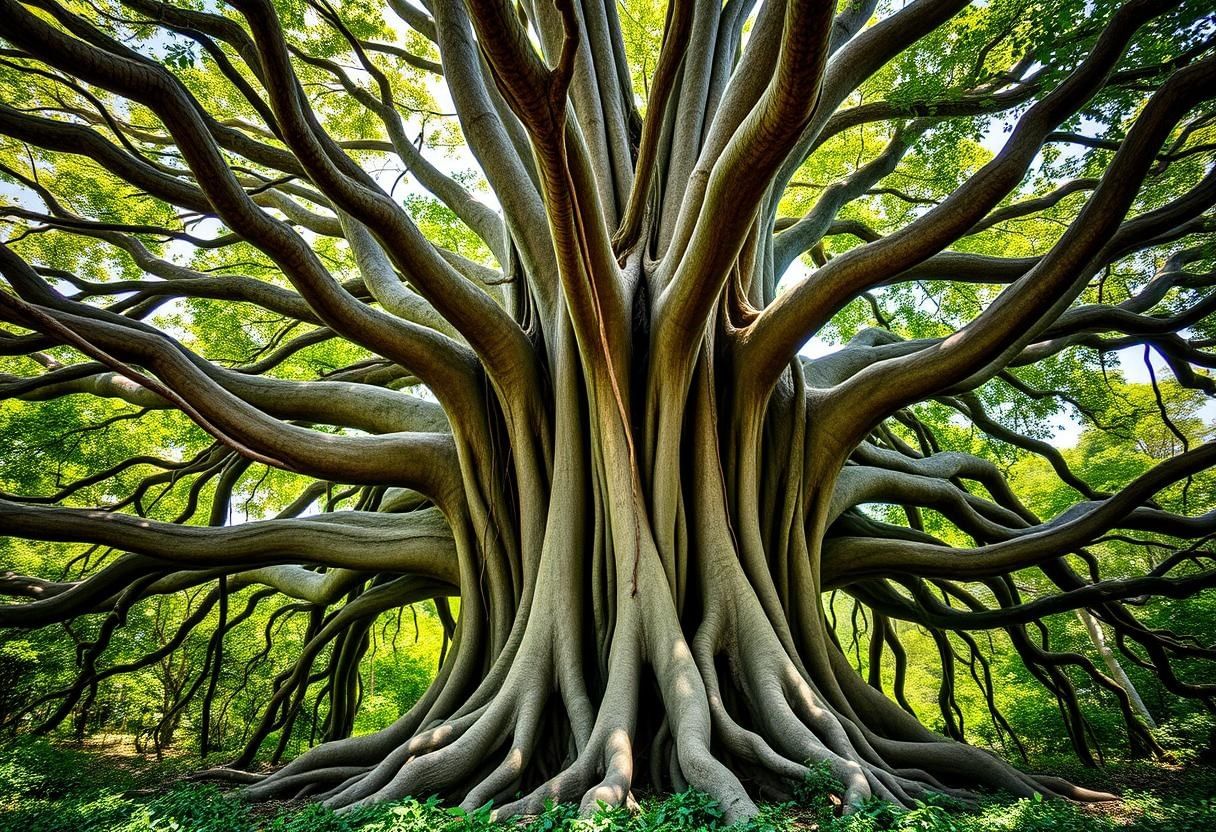 Supportive Banyan Roots
Supportive Banyan Roots
1. Prop Roots:
- These roots grow vertically downwards from aerial branches to provide additional support.
- They are commonly seen in banyan trees.
2. Stilt Roots:
- Aerial adventitious roots that grow obliquely downwards from the basal nodes of the main stem and enter the soil.
- Examples include maize and sugarcane.
3. Pneumatophores:
- These are geotropically negative (growing away from gravity) respiratory roots.
- Pneumatophores are primarily found in mangrove plants or plants that grow in swampy areas, such as Rhizophora and Avicennia.
II. Shoot System
The shoot system is the part of the plant that is above the ground. It includes the stem, leaves, flowers, fruits, and seeds. The main functions of the shoot system are to support the plant, conduct water and nutrients, and produce food through photosynthesis. 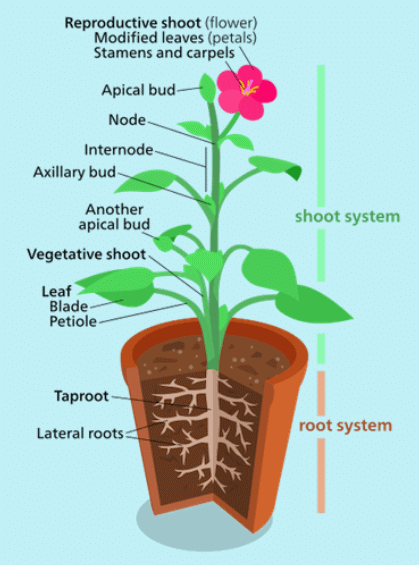
The stem is the part of the plant that supports the leaves, flowers, and fruits. It also conducts water and nutrients between the roots and the rest of the plant. The leaves are the main site of photosynthesis, where the plant makes food from sunlight, carbon dioxide, and water. The flowers are the reproductive organs of the plant, where pollination and fertilization occur. The fruits protect the seeds and help in their dispersal. The seeds contain the embryo of the new plant and are responsible for the next generation.
1. Stem
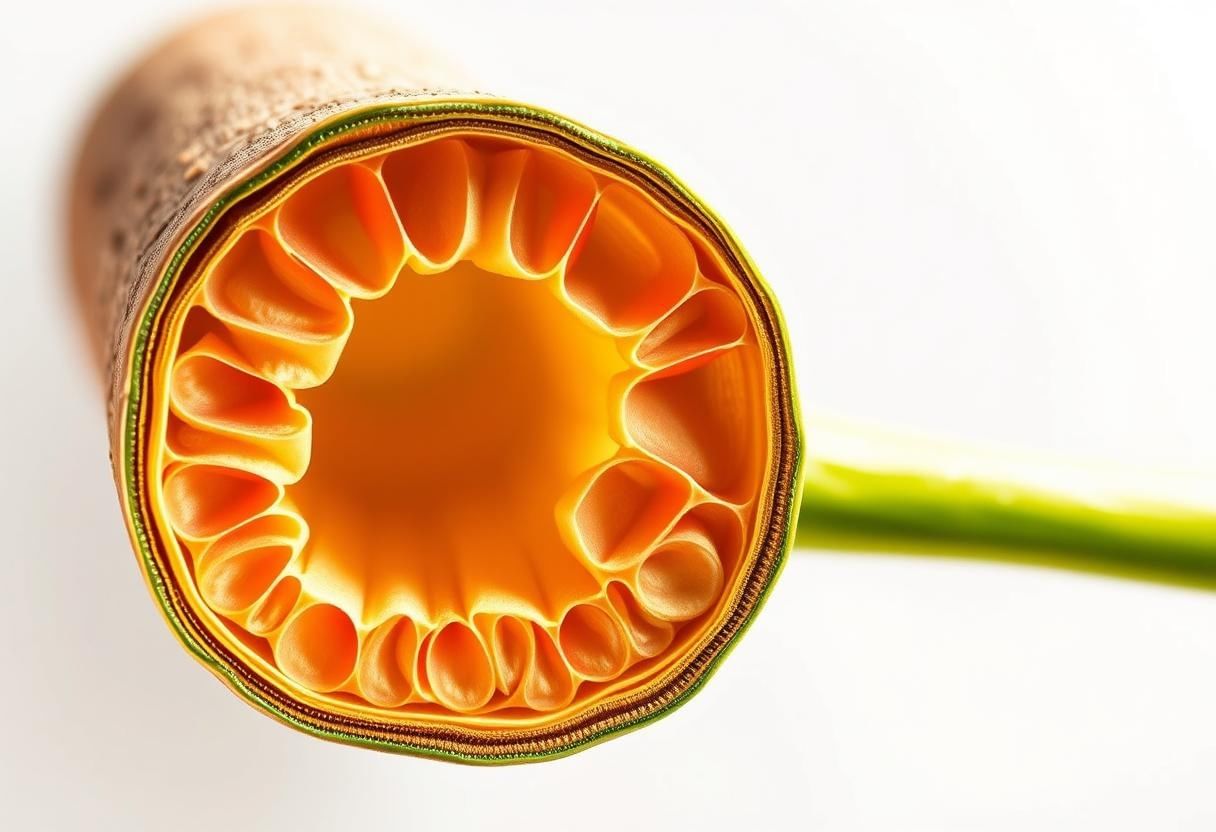 Plant Stem Structure
Plant Stem Structure
The stem is the part of the plant that grows upward from the ground and supports the branches, leaves, flowers, and fruits. It develops from the plumule of the germinating seed. The main functions of the stem include:
- Support: The stem provides support to the plant, helping it to stand upright and grow tall.
- Transportation: The stem transports water, minerals, and photosynthates (products of photosynthesis) between the roots and the other parts of the plant.
- Storage: Some stems, like those of sugarcane, store food.
- Vegetative propagation: Certain stems can produce new plants without seeds, such as in sugarcane.
- Protection: The stem can protect the plant from pests and diseases.
Types of Stems
There are two main types of stems: erect stems and weak stems.
A) Erect Stem
- An erect stem grows straight up without any support. It is strong and can support the weight of leaves, flowers, and fruits.
- Examples of plants with erect stems include bamboo and the banyan tree.
B) Weak Stem
A weak stem is unable to grow upright on its own. It either trails on the ground or climbs with the help of supports. Weak stems are further classified into:
(i) Climbers
- These stems climb with the help of tendrils, hooks, spines, prickles, or roots.
- Examples include pea, passion flower, and vine.
(ii) Twiner
- A twiner is a weak stem that grows by coiling around a support.
- An example is Ipomoea palmata.
(iii) Trailer
- Trailer plants have weak, long, and slender stems that trail along the ground.
- They do not climb and do not root from the nodes.
- Examples include portulaca and evolvulus.
(iv) Creeper
- Creeper plants have stems that creep on the ground.
- They may be runners, stolons, offsets, or suckers.
- An example is grasses.
Functions of the Stem
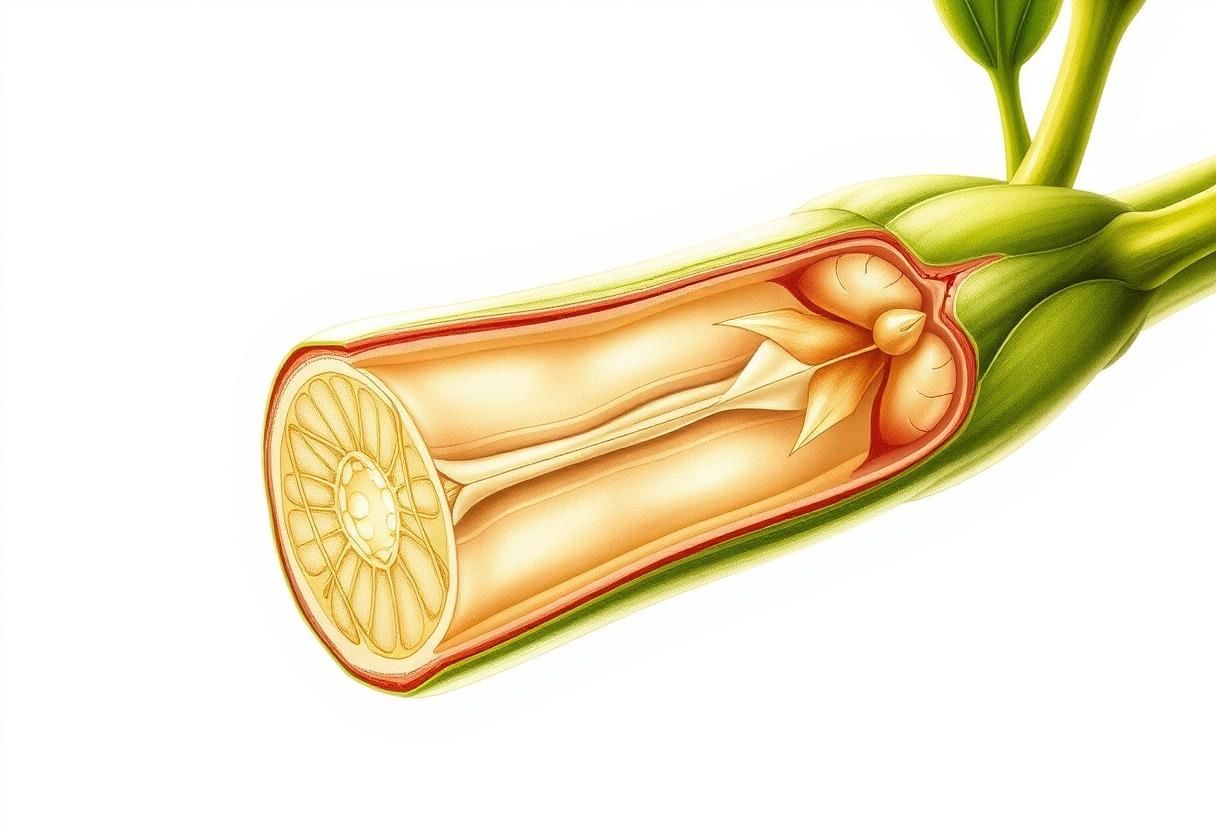 Plant Stem Functions
Plant Stem Functions
The stem plays a crucial role in the growth and development of the plant by performing the following functions:
- Support: The stem is crucial for supporting the plant. It holds up the leaves, flowers, and fruits, connecting them to the roots. In trees and shrubs, the main stem or trunk provides a strong, upright structure that supports branches, allowing leaves to reach sunlight more effectively.
- Transportation: The stem acts as a transport system within the plant, carrying water, nutrients, and products of photosynthesis between the roots and leaves. It facilitates the movement of water and sap both vertically and laterally within the plant.
- Storage: Stems have the ability to store water and products of photosynthesis. For instance, cacti store water in their stems. Additionally, some plants, like the sago palm and sweet palm, store products of photosynthesis, such as starch, in their trunks.
- Photosynthesis: While the leaves are the primary organs for photosynthesis in most plants, young green stems can also perform this function. In certain species, like cacti, the stem may play a limited role in photosynthesis.
- Asexual Reproduction: In many plant species, the stem is involved in asexual reproduction, helping to propagate the plant without the need for seeds.
- Food Transfer: The stem is responsible for moving organic food produced in the leaves to other parts of the plant, ensuring that all parts receive the necessary nutrients for growth and development.
2. Bud
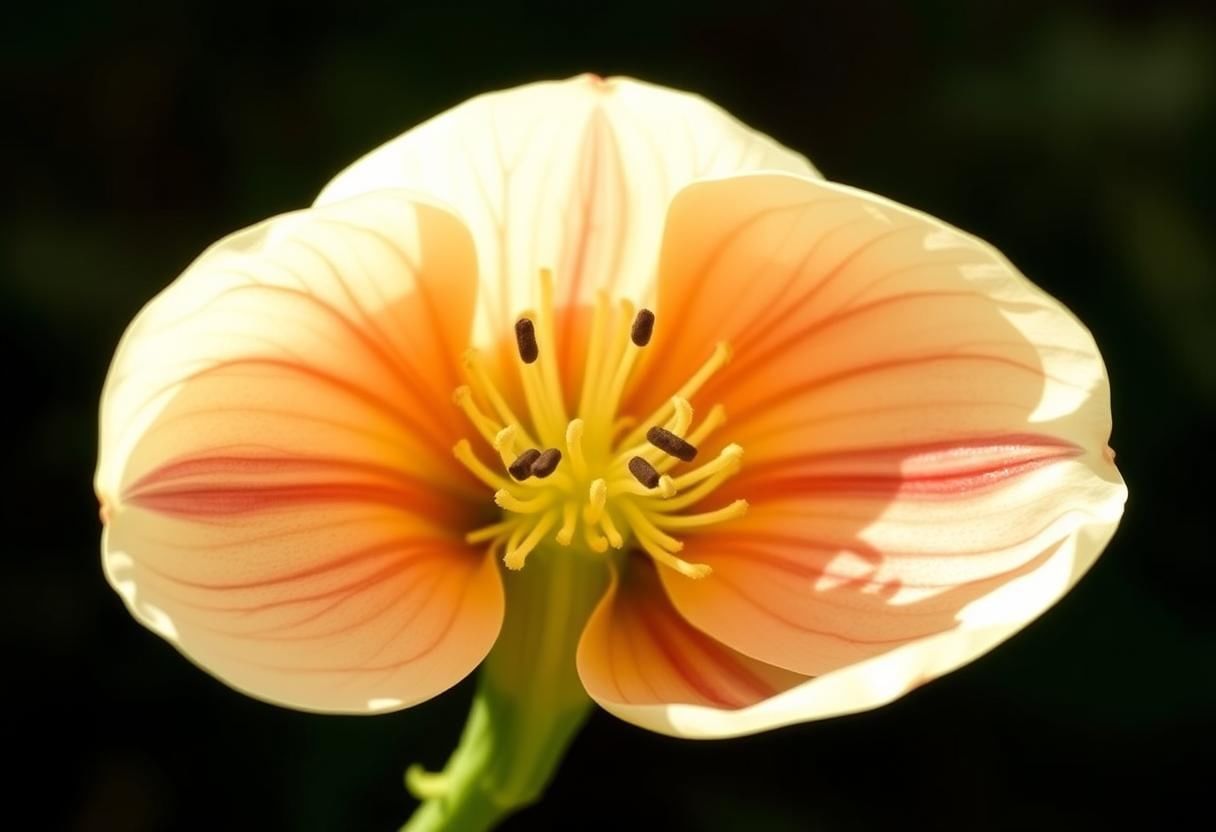 Flower Bud Structure
Flower Bud Structure
A bud is an undeveloped shoot that typically occurs in the axil of a leaf or at the tip of a stem. The stem of a bud is very short, and its leaves are tightly packed, overlapping each other. The inner leaves are crinkled and folded to fit into the small space, while the outermost leaves, known as bud scales, are often thicker and tougher. These scales protect the delicate inner leaves from drying out, damage by birds, insects, or fungi, and to some extent, from temperature extremes. At the end of the bud's short stem, there is either a flower or a growing point where rapid cell division will occur later when the next bud is forming.
Types of Bud
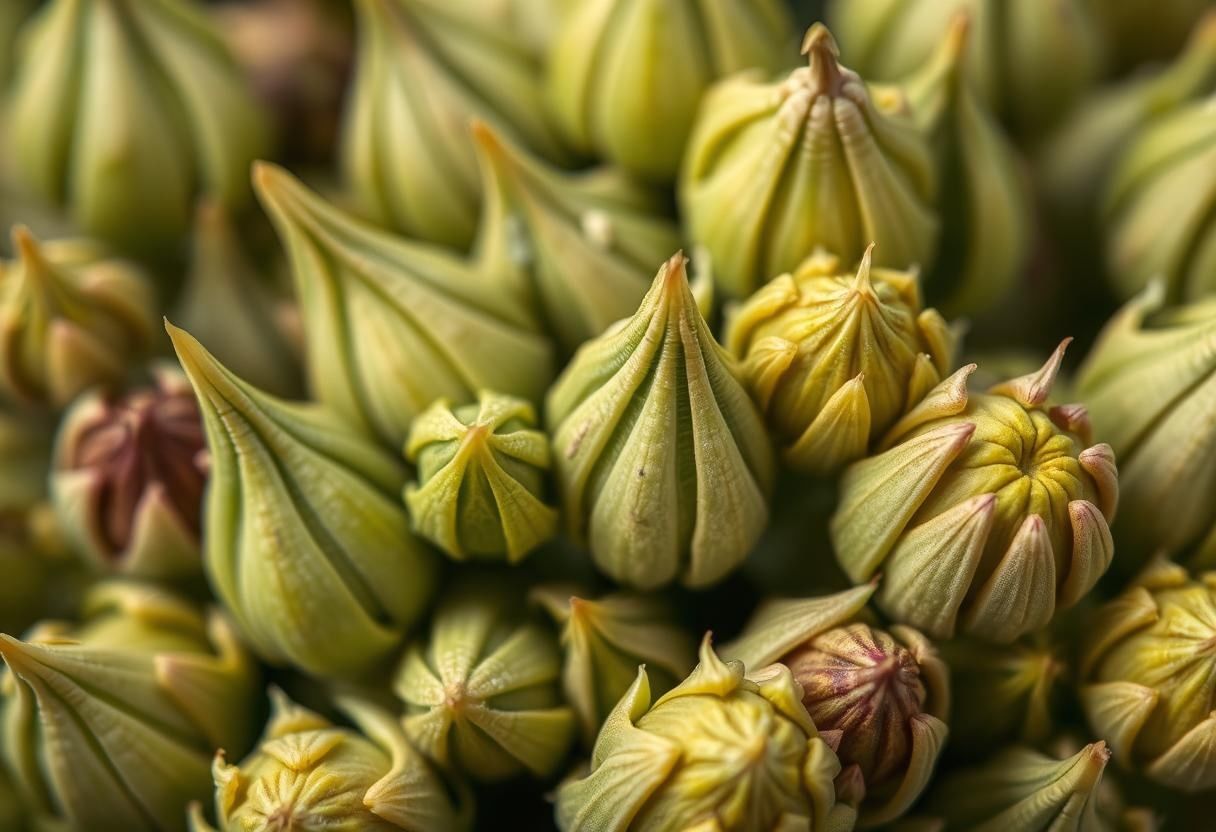 Types of Plant Buds
Types of Plant Buds
There are three main types of buds:
A) Terminal Bud
- A terminal bud is located at the tip of a stem. It is responsible for the upward growth of the plant.
B) Axillary Bud
- An axillary bud is found in the axil of a leaf where the leaf joins the stem. Axillary buds can develop into branches or flowers.
C) Adventitious Bud
- An adventitious bud occurs in unusual locations, such as on the trunk or roots of a plant. Some adventitious buds may be former axillary buds that are now hidden under the bark, while others are completely new formations.
- Cablage is a specific type of bud.
- Cloves are aromatic flower buds used as a spice.
3. Leaf
Different plants have specific types of leaves. Leaves are the main sites of photosynthesis. They take up carbon dioxide (CO2) from the atmosphere, water and other nutrients from the soil, and energy from sunlight. The color of leaves is green due to the presence of the pigment chlorophyll. When the amount of chlorophyll in leaves decreases, the color of the leaves can change, often turning yellow. 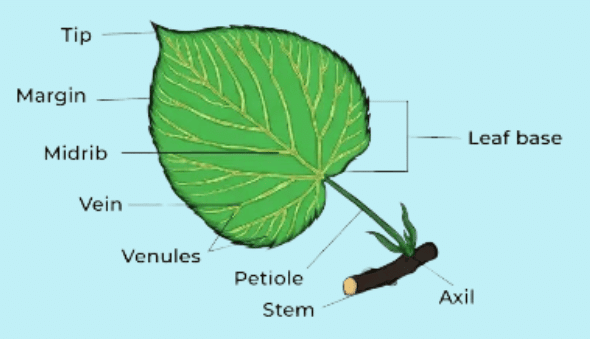
Functions of Leaves
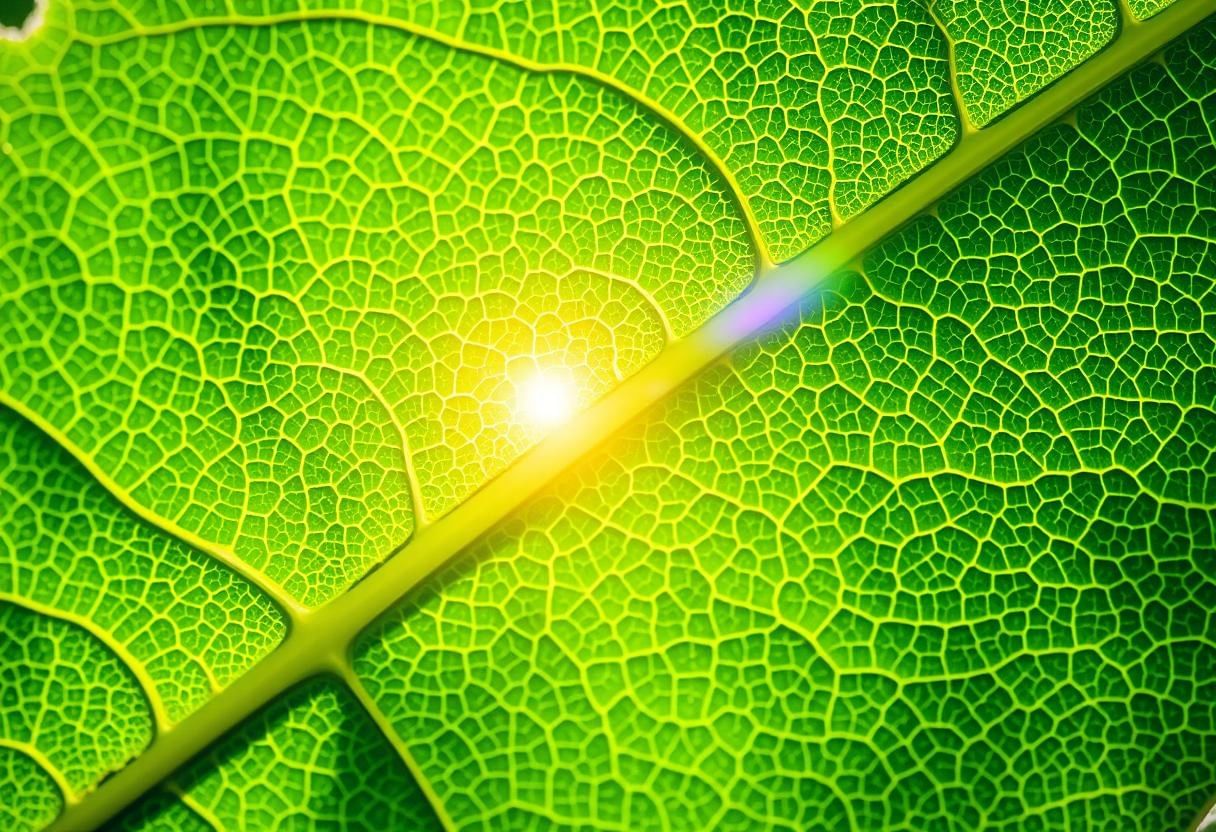 Photosynthesis in Leaves
Photosynthesis in Leaves
Some important functions of leaves include:
- Manufacture of Food: Green leaves are primarily responsible for making their own food through a process called photosynthesis. This process requires sunlight and the green pigment chlorophyll. During photosynthesis, leaves combine water and carbon dioxide to produce food, which is why plants are known as autotrophs. This process is fundamental to the survival of the plant and provides energy for growth and development.
- Respiration and Photosynthesis: Leaves contain tiny openings called stomata that facilitate the exchange of gases between the air and the plant. Both respiration and photosynthesis occur through these stomata. Respiration is the process by which plants take in oxygen and release carbon dioxide, while photosynthesis involves the uptake of carbon dioxide and the release of oxygen.
- Evaporation of Water: The water absorbed by the plant's roots is released from the surface of the leaves during the day in a process known as transpiration. This process mainly occurs through the stomata and plays a vital role in helping the plant absorb water and minerals from the soil. Transpiration also aids in the transportation of these essential nutrients to the upper parts of the plant.
- Storage of Food: Some plants, such as Indian aloe and portulaca, as well as the thick leaves of onions, have the ability to store food and water for later use. The fleshy leaves of plants in arid regions can store large quantities of water, mucilage, and food, helping them survive in harsh conditions.
- Vegetative Propagation: Leaves from certain plants, such as Bryophyllum, Begonia, and Kalanchoe, can produce buds that develop into new plants through a process called vegetative reproduction. When the leaf comes into contact with the soil, the edges can produce roots and a bud that grows into a new plant, allowing for the propagation of the species.
4. Flower
A flower is the reproductive unit in angiosperms. A typical flower has four different whorls arranged on the swollen end of the stalk or pedicel called the thalamus or receptacle. These four whorls are the calyx, corolla, androecium, and gynoecium. 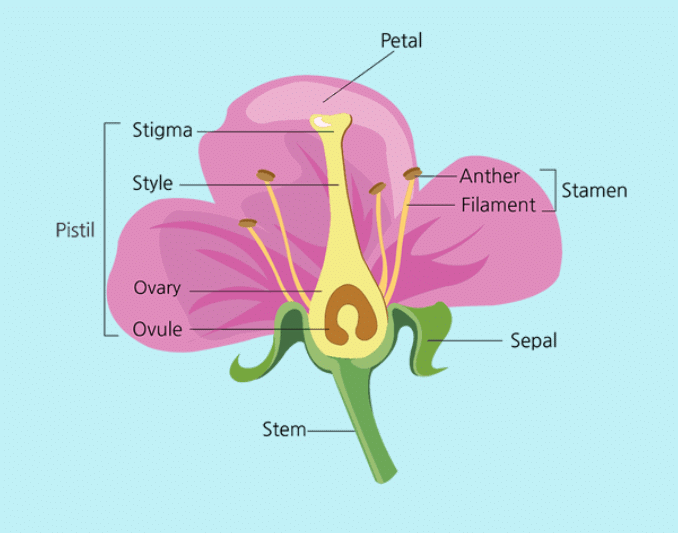 Flower
Flower
Parts of a Flower
- Calyx: The calyx is the outermost whorl of the flower, and each part of the calyx is called a sepal. Sepals are green, leaf-like structures that protect the flower in its bud stage.
- Corolla: The corolla is composed of petals, which are often brightly colored to attract insects such as butterflies and honeybees for pollination.
- Androecium: The androecium is composed of stamens. Each stamen consists of a stalk or filament and an anther. Meiosis occurs in the anther, producing pollen grains.
- Gynoecium: The gynoecium is the female reproductive part of the flower, made up of one or more carpels. A carpel consists of three parts: the stigma, style, and ovary. The ovary is the enlarged basal part of the carpel, on which an elongated tube called the style lies. The style connects the ovary to the stigma, which is usually at the tip of the style and serves as the site for pollen grain reception.
5. Fruit
- Fruits are the structures in flowering plants that contain seeds. They develop from the ovary of the flower after fertilization and mature into their final form.
- Fruits serve to protect the seeds inside them and assist in spreading them to new locations.
- Figs are an example of multiple fruits, which form from a cluster of flowers.
- Apples are considered true fruits because they develop from the ovary of the flower and contain seeds.
- Interestingly, the part of figs and apples that we eat comes from the thalamus (the thickened part of the stem), not directly from the ovary.
III. Different Types of Plants
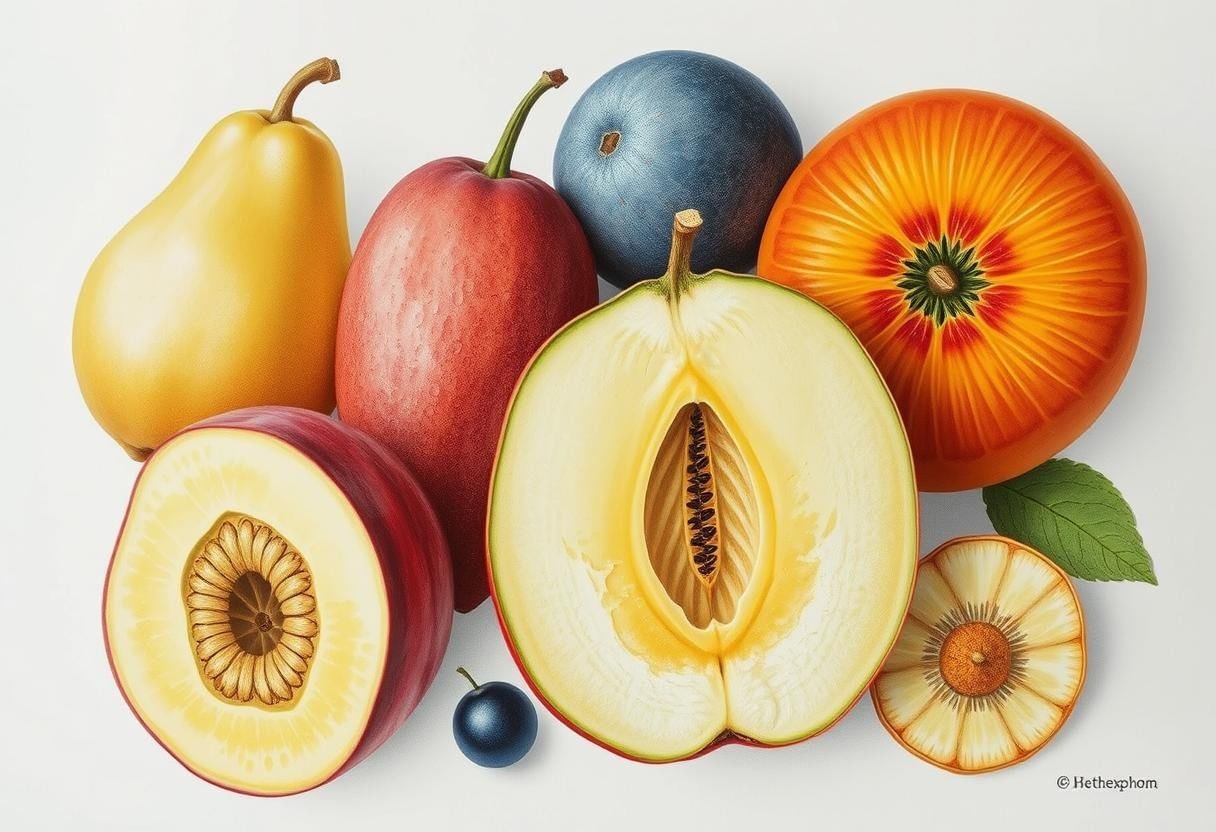 Seed-bearing fruit structure
Seed-bearing fruit structure
Plants can be classified in various ways based on their physical features, life span, and the geographical areas where they grow. The different classifications of plants are as follows:
- Physical Characteristics: Plants can be grouped based on their physical traits such as size, shape, and structure.
- Life Span: Plants are classified according to their life span, which can be short, medium, or long.
- Geographical Locations: Plants can also be classified based on the regions where they naturally grow, which can include forests, deserts, mountains, and aquatic environments.
On the Basis of Physical Structure
- Herbs: These are soft-stemmed plants that produce seeds and typically lack a woody structure to support themselves. Herbs are commonly used to enhance the flavor of food, in medicinal preparations, and in the production of perfumes. Examples of herbs include eggplant, coriander, tomato, and tulsi.
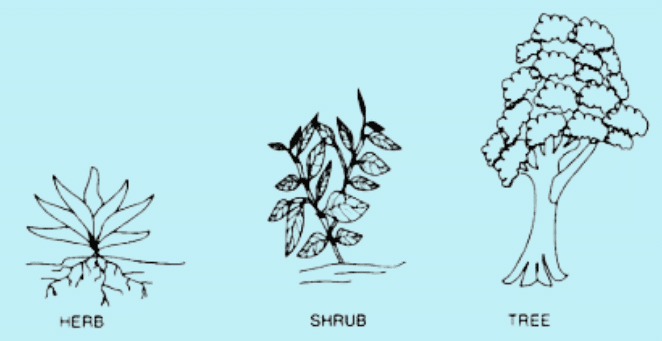
- Shrubs: These are woody plants that are small to medium in size and have multiple main stems arising from the base. Shrubs are often used in gardens and landscapes for their flowers and foliage. Examples of shrubs include rose, bougainvillea, and cotton.
- Trees: Trees are large, woody plants characterized by a single trunk that supports branches and leaves. Trees can vary significantly in height, with some being very tall and others being of medium size. Examples of trees include mango trees and banyan trees.
- Climbers: Climbers are plants with weak stems that require support to grow upward. These plants often use other structures, such as trellises or fences, to climb. Examples of climbers include money plant, grapevine, and pea.
- Creepers: Creepers are plants with weak stems that spread horizontally across the ground. Unlike climbers, creepers do not require support to grow, as they spread flat on the soil surface. Examples of creepers include watermelon, pumpkin, and bottle gourd.
On the Basis of Life Span
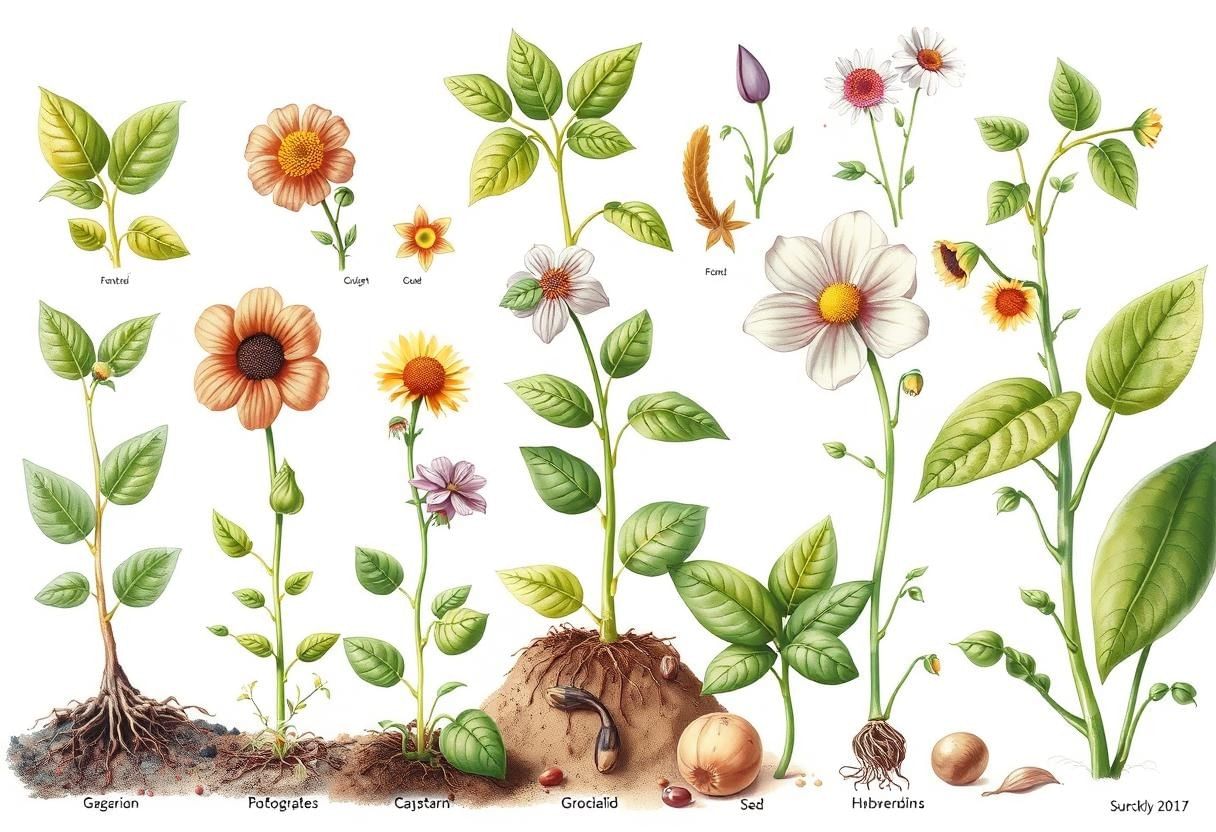 Plant Life Cycles
Plant Life Cycles
- Annual Plants: These plants complete their entire life cycle in one year, from seed germination to seed production. Examples include wheat, maize, and sunflowers.
- Biennial Plants: These plants take two years to finish their life cycle. In the first year, they develop roots, stems, and leaves, and in the second year, they produce flowers. While carrots and radishes are biennial, they are often grown as annuals in farming.
- Perennial Plants: These plants can live for several growing seasons. They have roots that spread widely underground. Perennial flowering plants grow and bloom in spring and summer and lose their leaves in autumn and winter. Examples include mango and apple trees.
On the Basis of Region
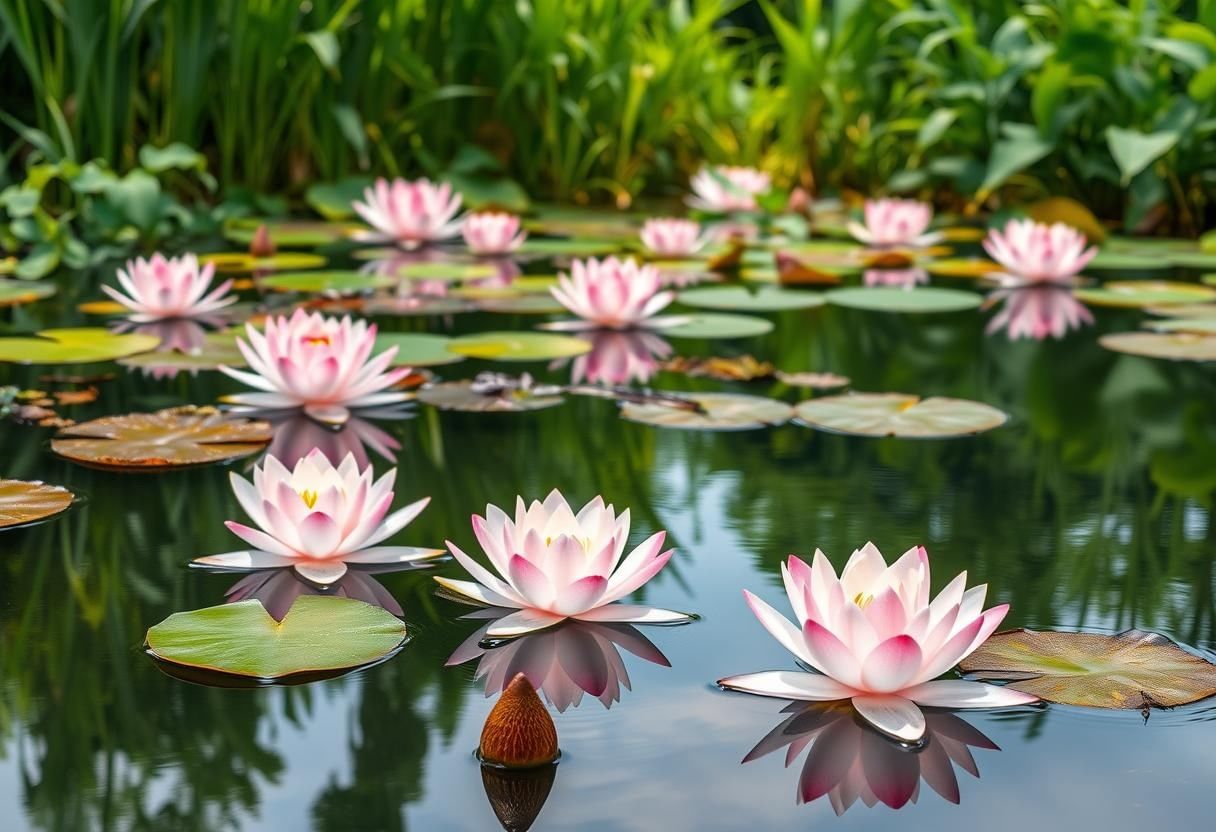 Water Lily Habitat
Water Lily Habitat
- Hydrophytes: These plants thrive in or on water and possess adaptations such as thin cuticles, broad flat leaves, air sacs for flotation, reduced root systems, and waxy coatings on their leaves. Examples include lotus, hydrilla, and water lily.
- Xerophytes: Xerophytes are adapted to arid environments with limited water availability, such as deserts. They typically have deep root systems, small pointed leaves covered with a waxy layer, thick cuticles, and fewer stomata to minimize water loss.
- Mesophytes: These plants are found in environments with moderate moisture levels, neither too dry nor too wet. Examples include mango and neem trees. Mesophytes are vulnerable to flooding because their roots struggle to respire in waterlogged conditions.
- Halophytes: Halophytes are specialized for saline environments, such as saline semi-deserts, mangrove swamps, marshes, and coastal areas. Some halophytes, like rhizophora, have unique adaptations, such as aerial roots, that enable them to thrive in salty conditions.
Significance and Importance of Plants
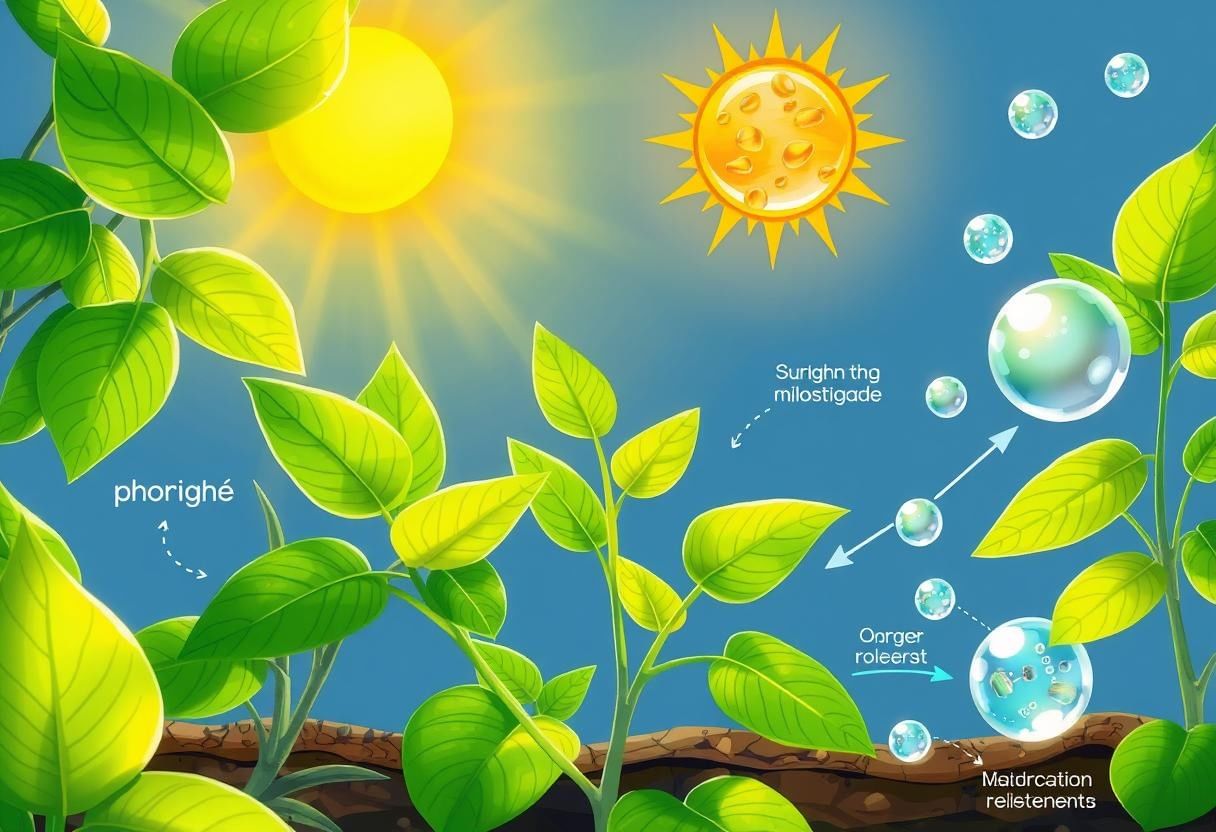 Photosynthesis Process
Photosynthesis Process
Earth is often referred to as a green planet because of the abundance of plants. In fact, plants are considered to be among the first living organisms to appear on our planet. They play a crucial role in various aspects of our environment and well-being. Here are some of the key benefits and roles of plants:
1. Gaseous Balance and Photosynthesis
- Photosynthesis: Plants help maintain the balance of gases in the air through the process of photosynthesis. They absorb carbon dioxide (CO2) emitted by animals and release oxygen, which is essential for the survival of most living organisms.
2. Environmental Regulation
- Plants contribute to regulating temperature, preventing soil erosion, maintaining ecological balance, supporting rainfall, and preserving soil fertility through various mineral and water cycles.
3. Habitat for Wildlife
- Plants provide shelter and habitat for various animals, including birds, monkeys, squirrels, and many other species. This biodiversity is essential for a healthy ecosystem.
4. Autotrophic Nature
- Plants are called autotrophs because they produce their own food using sunlight, chlorophyll, carbon dioxide, and water. They provide a wide range of food sources for humans and animals, including carbohydrates, fats, proteins, vitamins, and minerals.
5. Oil Production
- Plants are a source of various edible oils, such as mustard oil, groundnut oil, coconut oil, and sunflower oil. These oils are primarily obtained by crushing seeds, although some oils of commercial importance are extracted from leaves and fruits.
6. Medicinal Value
- Many plants have significant medicinal value. For example, plants like Tulsi, neem, garlic, aloe vera, cinchona, and poppy are known for their health benefits and are used in traditional medicine.
7. Edible Flowers
- Some flowers are consumed as food in different regions of India. For instance, kachnar in Uttar Pradesh, banana flower in Kerala, and sahjan flower in Maharashtra are examples of edible flowers.
8. Wood and Fiber Production
- Wood: Plants like teak, sal, and sesam provide wood for various uses. Plants like bamboo are used for making paper, while plants like babul, acacia, and kikar produce gum. Plants like cotton and jute provide fiber for making cloth, bags, and ropes.
9. Beverages and Spices
- Plants are the source of various beverages and spices, including tea, coffee, and alcoholic drinks. They also provide a wide range of spices, perfumes, dyes, and natural colors.
10. Nutrient Sources
- Cereals: Rice, wheat, millet, maize, barley, and oats are important cereal crops.
- Pulses: Various types of grams, such as arhar, moong, and horsegram, are important sources of protein.
- Roots: Vegetables like radish, turnip, carrot, and beetroot are consumed for their nutritional value.
- Stems: Plants likeginger, garlic, potato, andonionare important sources of food.
- Leaves: Vegetables like cabbage and spinach are consumed for their nutritional benefits.
- Nuts: Nuts like almonds, walnut, cashew nut, and peanut are important sources of healthy fats and proteins.
In summary, plants are not only essential for maintaining ecological balance and providing food but also contribute significantly to our economy and health through various products and services. Their role in sustaining life on Earth cannot be overstated.
Special Plants and Their Features
Plants have unique adaptations that help them survive in different environments. Here are some special plants and their distinctive features:
1. Desert Oak
- The Desert Oak is a medium-sized, slow-growing tree found in the dry desert regions of Northern Territory, South Australia, and Western Australia.
- Adaptation: It has deep roots that extend three times the length of the tree to search for underground water. Instead of traditional leaves, it has long, segmented branchlets. Indigenous Australians have used this tree as a source of water.
2. Nepenthes (Pitcher Plant)
- The Nepenthes, or Pitcher Plant, is a carnivorous and insectivorous plant that traps insects, frogs, and even small mammals in its pitfall trap.
- Adaptation: It has a modified leaf that forms a cavity over its pitfall trap. To attract insects, it emits a pleasant smell. Although it can perform photosynthesis due to the presence of chlorophyll, it supplements its nitrogen intake by digesting insects. Other examples of insectivorous plants include the Viral Fly Trap and Sundew Plant (Drosera).
3. Khejri Tree (Prosopis Cineraria)
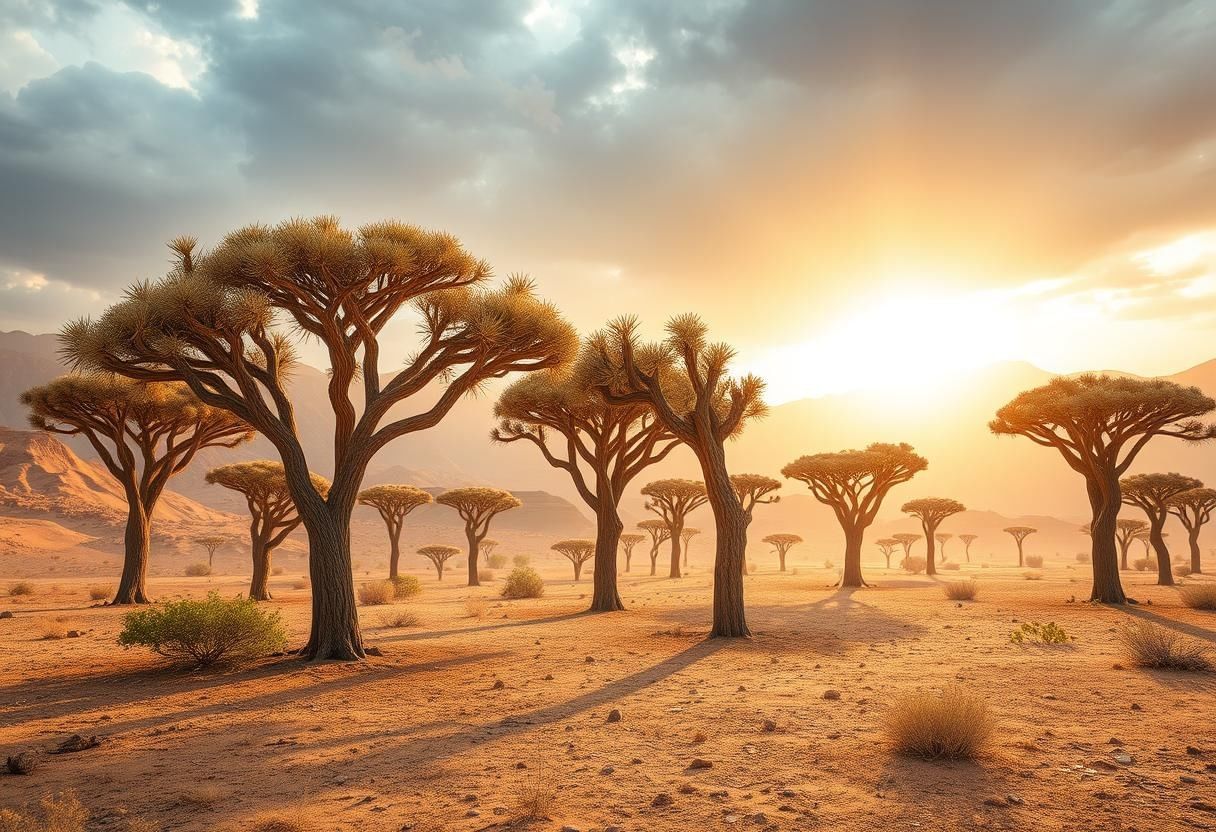 Khejri Tree Landscape
Khejri Tree Landscape
- The Khejri Tree, also known as the Prosopis Cineraria, is the state tree of Rajasthan. Environmentalists have raised concerns about its declining population.
- Significance: It covers about two-thirds of the total geographical area of Rajasthan and supports the rural economy. Its fruits are a rich source of protein, and its bark is used for medicinal purposes. The wood of the Khejri Tree is resistant to insect damage.
4. Banana
- Contrary to popular belief, the banana stem is not a true stem but a flower stalk of the banana plant.
- Classification: Banana is classified as a herb. Both the flower and fruit of the banana plant are edible.
5. Croton
- Croton is used as an indicator plant for water deficiency.
- Method: When croton leaves begin to wilt, it signals the need for water in nearby crops.
6. Banyan Tree
- Life Cycle: The banyan tree begins its life as an epiphyte, growing on another plant.
- Support: As it matures, old banyan trees develop aerial prop roots that act as pillars, providing support to the tree.
7. Introduction of Plants to India
- Some plants have their origins in South America and were introduced to India, including tomato, potato, and green chili.
- Plants like cabbage, orange, and pea were brought from Europe, while bhindi(okra), coffee, and bean were introduced from Africa.
These examples highlight the incredible diversity of plants and their unique adaptations to survive and thrive in various environments.
Nutrient in Plants
Plants can be classified into two groups based on their nutrient habits: autotrophs and heterotrophs.
1. Autotrophs
- Autotrophs are plants that can produce their own food using light, water, and carbon dioxide (CO2). Because they produce their own food, they are sometimes called producers.
- Examples of autotrophic plants include green plants that photosynthesize and some types of algae.
2. Heterotrophs
Heterotrophs are plants that cannot prepare their own food and are dependent on other plants and animals for their nutrition. They can be further divided into the following types:
(i) Parasites
- Parasitic plants cannot synthesize their own food because they lack chlorophyll. They have specialized structures called sucking roots that allow them to take prepared food from their host plants.
- Examples of parasitic plants include cuscuta(dodder) and broomrape.
(ii) Saprophytes
- Saprophytic plants grow on decaying organic matter, such as dead plants or animals, and absorb organic food material from this matter.
- Examples of saprophytic plants include mushrooms, monotropa(a type of Indian pipe plant), bacteria, and fungi.
(iii) Symbionts
- Symbiotic plants are two organisms that live in close physical association and benefit each other. For example, lichens are a symbiotic association between a fungus and an alga or cyanobacterium.
- Mycorrhizae is another example where a fungus forms a symbiotic relationship with the roots of a plant, aiding in nutrient absorption.
(iv) Insectivorous Plants
- Insectivorous plants grow in swampy soil that is deficient in nitrogen. To obtain nitrogen, they eat small insects.
- These plants can also perform photosynthesis. Examples of insectivorous plants include Pitcher Plants (Nepenthes), Sundew (Drosera), and Venus Fly Trap.
Food Chain
A food chain illustrates the feeding relationships among different organisms within a specific environment or habitat. At the base of any food chain are plants, which produce their own food through the process of photosynthesis. 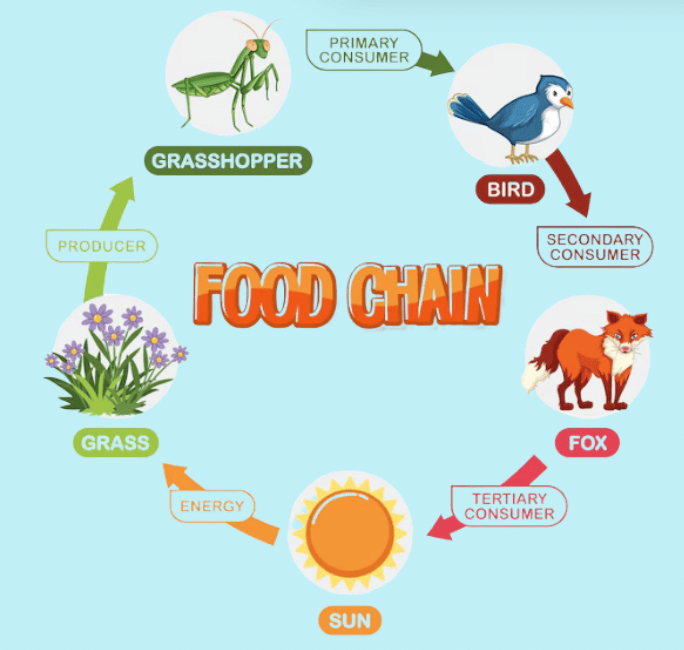
Producers and Consumers
- Producers: Plants are known as producers because they create their own food using sunlight, water, and carbon dioxide.
- Herbivores (Primary Consumers): These are animals that eat plants. They are the first level of consumers in the food chain.
- Carnivores (Secondary Consumers): These animals eat herbivores. They are the second level of consumers.
- Tertiary and Quaternary Consumers: These are animals that eat other carnivores or herbivores, and they occupy higher levels in the food chain.
Role of Decomposers
Decomposers, although not depicted in the food chain, play a crucial role by breaking down dead organic matter and converting it into inorganic matter. This process is essential for recycling nutrients back into the ecosystem.
Importance of Plants in Child Development
Understanding Human Survival
By learning about the various roles that plants play in the life of humans and animals, such as providing oxygen and food, children can grasp the fundamental importance of plants for human survival.
Sensitivity Towards Nature
Studying the role of plants in nature helps children become more sensitive and aware of the environment, fostering a sense of responsibility towards nature.
Curiostity and Interest in Plants
Observing the growth and development of plants can spark curiosity in children, motivating them to learn more about plants and their life processes.
|
21 videos|139 docs|35 tests
|
FAQs on Notes: Plants - EVS & Pedagogy Paper 1 for CTET & TET Exams - CTET & State TET
| 1. What is the full form of CTET and its significance in the teaching profession? |  |
| 2. How can I prepare effectively for the CTET and State TET exams? |  |
| 3. What are the eligibility criteria for appearing in the CTET exam? |  |
| 4. What is the exam pattern for CTET, and how is it structured? |  |
| 5. How often is the CTET exam conducted, and when are the results announced? |  |





















